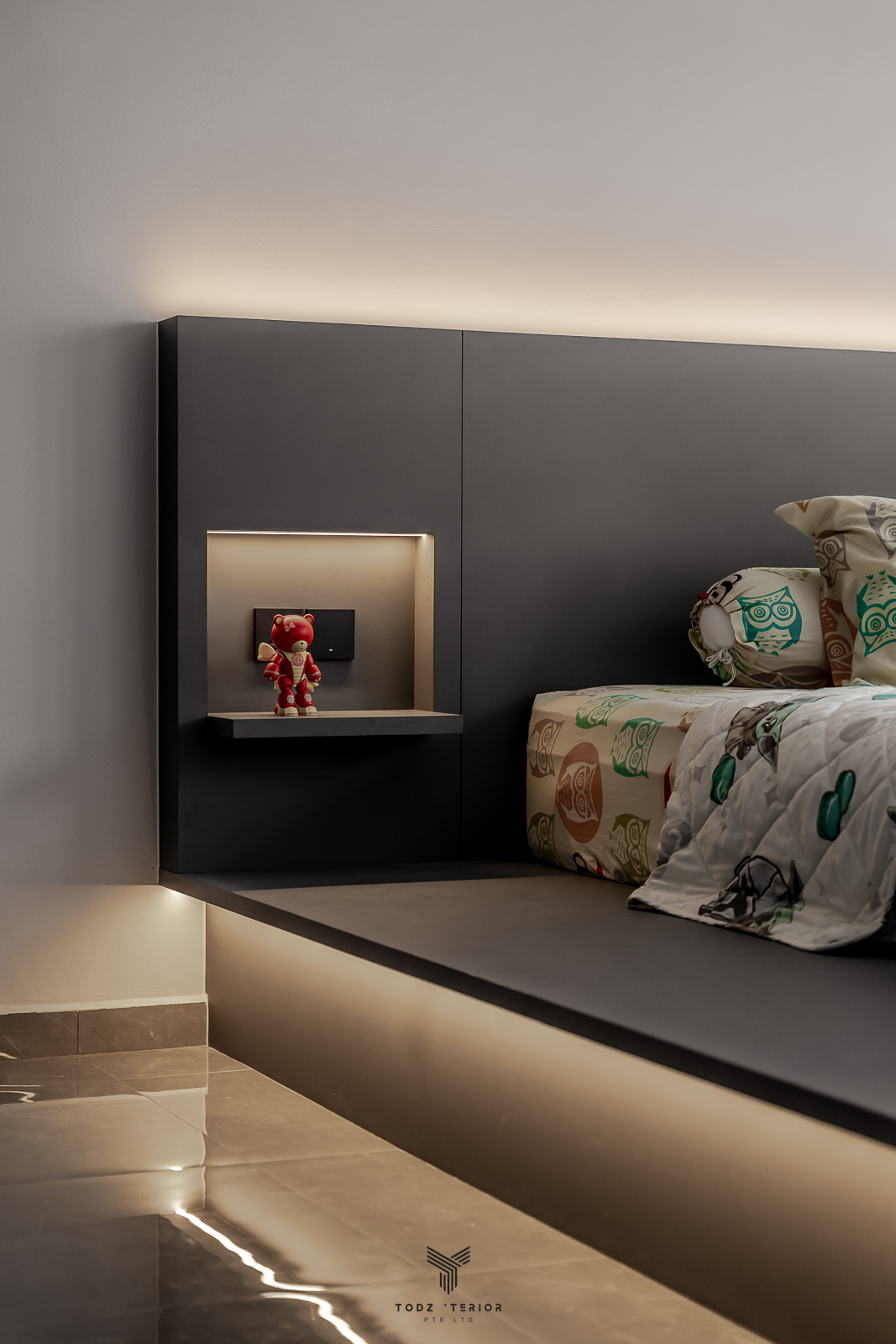In the relentless pursuit of perfection that defines much of modern life, Wabi Sabi design style offers a refreshing and grounding alternative. Rooted in ancient Japanese philosophy, Wabi Sabi invites us to find beauty in the incomplete, the worn, and the understated—qualities that are often overlooked in the fast-paced, urban environment of Singapore. For those of us living in HDB flats, where space can feel limited and every inch counts, adopting this aesthetic can shift our perspective, turning our homes into tranquil retreats.
In This Article
ToggleAs I step back to consider how to integrate this design philosophy into the busy rhythm of daily life, I see how Todzterior offers exactly what we need—personalized, comprehensive renovation and interior design services that allow you to bring this ethos to life. It’s not about perfecting your space; it’s about creating a home that feels naturally yours, where simplicity, authenticity, and thoughtfulness take center stage.
In a world where clutter can overwhelm and perfection feels unreachable, why not let go? Why not design a space that reflects the beauty of the here and now?
We Design Spaces That Speak Your Style
As interior designers, we don’t just renovate—we transform homes into personalized sanctuaries where beauty meets function.
The Essence of Wabi Sabi Interior Design
This is not, strictly speaking, a matter of decoration and design, but rather of shedding a whole mode of living that values the delicate bruises, the worm-eaten, and the lichen-grown. Consider a wooden table with worn out marks or a pottery piece that has been broken but joined together with gold.
Three Imitative Patterning Architectural Examples. The Wabi Sabi design style encapsulates these principles and brings organic aesthetic into your home, through the use of natural materials, earthy colors and textures.
In the specific setup of the Singapore HDBs where many of the houses are small and basic, this style is endlessly helpful. It provides some comfort and usual atmosphere in the house, which is quite opposite to the stressful city life. And the best part? In fact, you don’t have to spend a lot of money to do it and that is what makes it stand out from other diets.

Why Wabi Sabi Design Style is Perfect for Singapore HDBs
If you’ve ever been bogged down by mess or the chase for a pristine home then Wabi Sabi is the solution. Most Singaporeans especially the one living in the HDB flats always struggle to find more space to create and design at the same time. This is where Wabi Sabi stands out in its best way. It inspires you to ‘accept the imperfections’ and design to make the place comfortable, cozy and practical.
Little blemishes, a line in the wall that is not straight, the floor is beginning to creak, nothing is perfect, and people do not consider it a downside. Raw form materials including wooden, stones, and clay are ideal for this style, and have a great appeal in small HDB flats. Fetch and functionality come together in the Wabi Sabi design style The use of raw wooden shelves or leaving a plain, natural concrete floor does not only serve its purpose but also looks great.
At Todzterior interior design, we appreciate the need of coming up with homes that are uniquely yours as well as ones that meet your needs. That is why we offer extensive renovation services covering different aspects to design and build areas that embody Wabi Sabi, yet learned from, and tailored to your daily experiences.
Interior Design Ideas for Wabi Sabi in Your HDB
Expanding on the Wabi-Sabi design style for your HDB, each element offers a deeper understanding of how to embrace imperfection and simplicity in a modern Singapore home. Wabi-Sabi’s emphasis on authenticity and natural beauty can transform your space into a serene retreat amidst the urban environment, allowing your home to tell a story of its own.
1. Embrace Imperfection
In a world obsessed with sleek, flawless designs, Wabi-Sabi challenges us to see beauty in the worn, the aged, and the imperfect. In your HDB home, this can be realized by opting for raw, natural materials like wood, stone, and bamboo. These materials age gracefully and develop unique characteristics over time, much like the Japanese concept of “kintsugi,” where broken pottery is mended with gold, making the cracks part of the object’s story. By choosing items that show natural wear and tear, such as weathered wooden furniture or stone countertops, you’re not only creating an authentic living space but also allowing it to evolve with time.
Distressed finishes can also play a key role in embracing imperfections. Think of a dining table with subtle scratches or faded paint on a wall—these small details evoke a sense of history and warmth, making the space feel lived-in and personal. Rather than hiding these imperfections, the Wabi-Sabi design style celebrates them. The idea that “things don’t have to be perfect to be beautiful” allows you to create a space that is relaxed, natural, and undeniably unique.

2. Minimalism: Less is More
Wabi-Sabi teaches us that simplicity and decluttering create peace. In the often small spaces of Singaporean HDB flats, adopting a minimalist approach helps to create a sense of calm and openness. Decluttering is not just about removing excess items; it’s about creating a purposeful space where everything serves a function and adds value to the room. Instead of filling your home with decorative objects, focus on a few key pieces that bring you joy and are essential to your lifestyle.
This minimalist approach can be enhanced by natural light. Opening up your windows, keeping window treatments light and simple, and letting sunlight pour into your home creates a sense of expansiveness. Natural light connects you with the world outside and gives your interior a gentle, natural glow—something central to the Wabi-Sabi aesthetic.
3. Integrating Natural Elements
Nature plays a huge role in Wabi-Sabi design. The philosophy encourages us to bring the outdoors in, creating spaces that are grounded in nature and evoke tranquility. One simple way to incorporate nature into your HDB is through plants and greenery. Adding indoor plants not only helps to purify the air but also creates a calm, serene environment. Choose hardy plants like ferns, peace lilies, or succulents, which thrive in low-light conditions and require minimal maintenance.
Natural materials such as bamboo, jute, rattan, and stone further reinforce the connection to the earth. Wooden furniture, stone accents, and even small elements like woven baskets can add warmth and texture to your home. These materials are tactile and soothing, creating a cozy, down-to-earth feel that embodies the spirit of Wabi-Sabi.
4. The Appeal of Raw and Unfinished Elements
Wabi-Sabi embraces the idea that things can remain unfinished and raw, allowing their natural beauty to shine. In a modern HDB setting, you can showcase the raw beauty of exposed brick or concrete walls to add character and texture to your space. These materials are timeless and durable, offering a sense of groundedness to your home.
Another option is incorporating unfinished wood into your design. Whether it’s through furniture, flooring, or shelving, raw wood adds warmth and a rustic feel to your space. The uneven grain and knots in the wood are reminders that nature is imperfect, and that’s where its beauty lies. This approach creates a sense of honesty and authenticity in your home, where materials are celebrated for what they are, not what they should be.
5. Imperfectly Perfect Objects
Wabi-Sabi thrives on objects that carry a story. Rather than opting for mass-produced items, choose vintage or antique pieces that show signs of wear. These items have a history, and the imperfections, such as scratches or faded colors, only add to their charm. Whether it’s a well-worn armchair, an antique mirror, or a set of vintage plates, these objects bring character and uniqueness to your home.
Similarly, handmade items fit seamlessly into the Wabi-Sabi design style. Whether it’s a hand-thrown ceramic vase or a woven basket, handmade objects have a certain irregularity and individuality that make them special. These pieces inject a personal touch into your home, reminding you of the human element behind them.
6. Soft Lighting: Warmth and Serenity
Lighting is key to creating the cozy, inviting atmosphere that Wabi-Sabi interiors are known for. Soft and warm lighting makes your home feel intimate and serene, providing a calming glow in the evenings. Opt for soft light bulbs, paper lanterns, or shaded lamps that diffuse light and create a gentle ambiance.
Maximizing natural light is equally important during the day. Keep curtains or blinds light and minimal to allow sunlight to flow into your home. Natural light enhances the textures of your materials and creates an organic connection between your home and the world outside.
7. Imperfect Symmetry: Creating Organic Balance
One of the most distinctive elements of Wabi-Sabi design is the idea of asymmetry. In contrast to rigid, perfectly balanced layouts, Wabi-Sabi encourages more organic, fluid arrangements. Furniture and decor don’t have to match perfectly or be arranged in symmetrical patterns. Instead, allow for some imperfect symmetry, where items are placed in a way that feels natural and spontaneous.
For instance, you might place a single floor lamp in one corner and balance it with a small chair or a stack of books on the other side of the room. This creates a relaxed, lived-in vibe that doesn’t feel overly structured.
8. Imperfectly Perfect Patterns
Natural materials often come with their own patterns, like the intricate grain of wood or the veins in a piece of stone. These natural patterns can be incorporated into your design to add texture and interest. The beauty of these patterns lies in their irregularity—they aren’t perfectly aligned, but they tell a story of their own.
Allowing for imperfectly aligned patterns in your space can also create a more organic feel. For example, you might choose handmade tiles for a kitchen backsplash where each tile is slightly different. These subtle irregularities make the space feel warm, unique, and real.

Affordable Elegance with Todzterior
Creating a Wabi Sabi-inspired home doesn’t mean you have to break the bank. The beauty of this style lies in its affordability. By focusing on simple, natural elements and letting go of the need for elaborate finishes, you can achieve a look that’s both elegant and cost-effective. At Todzterior, we’re committed to delivering personalized design solutions that meet your vision while respecting your budget. Whether you’re looking for a full renovation or simply want to add a few Wabi Sabi touches, we offer comprehensive interior design services that take care of every detail.
Imagine walking into your HDB after a long day and feeling an immediate sense of calm. That’s the magic of Wabi Sabi. It transforms your home into a sanctuary, a space where you can unwind and be present in the moment. At Todzterior, we help you achieve that transformation by combining affordability, thoughtful design, and expert renovation services.
Looking To Upgrade Your Living Space?
Share your WhatsApp number, and we will call you soonAccreditation



Frequently Asked Questions
What’s Next for Your HDB?
So, are you ready to let go of perfection and invite the beauty of Wabi Sabi into your home? How can embracing this design style change not just your living space but your entire outlook on life? It’s time to find out.
